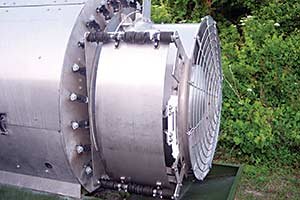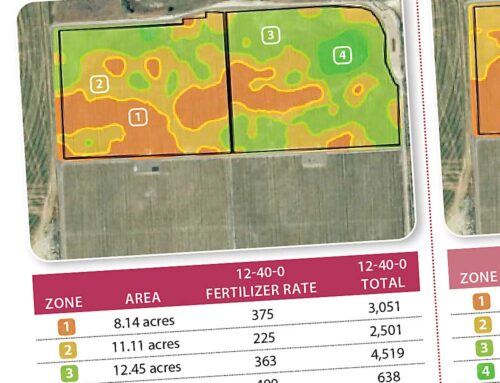
Over the years, fruit growers have traded in their shotgun-like pest control tools for more precise rifle-like tools and bullets capable of hitting moving targets with great accuracy. As they adopt these new weapons, they need to perfect their use of them.
During the Eastern Apple Precision Orchard Management Summit held in Geneva, New York, last March, there was not much discussion about the “bullets”—the insect and disease control chemicals—except to say they are like bullets, not like pellets in a shotgun, and that growers need to fire precisely the right ones at precise times, using different bullets for different pests at different stages of development.
Part of the discussion focused on the weapons—the sprayers that deliver the bullets into trees that are not the same as they once were. Small trees in high-density configurations are not the same as big trees with large canopies. Nor is there much room for error, for both environmental and cost-efficiency reasons.
Most of the discussion focused on aiming—how do orchardists hit the targets and, more importantly, how do they know when the targets are there and vulnerable to being hit? Unlike bygone days when growers “kept covered” with long-residual insecticides and fungicides applied on seven- to ten-day intervals—more often if it rained—growers have to find comfort even as they know they as less “covered.”
Precise insect management
In the damp, humid orchards of the eastern United States, growers face many challenges, says Cornell University entomologist Dr. Art Agnello, because there are so many pests.
“Growers are attempting to turn to newer reduced-risk pesticides, but these are more expensive and require more precise timing and use patterns because of their different modes of action,” he said.
Eastern growers face five major insect pests—plum curculio, apple maggot, codling moth, oriental fruit moth, and obliquebanded leafroller. Then there are secondary pests—mites, scales, aphids—and cyclic pests that sometimes appear—potato leafhoppers, stink bugs, Japanese beetles. Then new ones come along, like spotted wing drosophila and brown marmorated stinkbug.
Where once they could almost all be managed with repeated cover sprays of broad-spectrum insecticides, now they must be approached individually.
As they try to improve the precision of the process, Agnello said, growers need to remember that the key pests drive the pest management program, just as they always have. Growers need to know precisely when they show up, when they reach a stage that is vulnerable to control, when they start posing a threat to the crop, and when they stop being a threat.
The discovery that insects and diseases develop according to accumulated temperatures has allowed researchers to create models based on growing degree-day accumulations.
“During the last several years, an interdisciplinary group of researchers at Cornell University has developed a Web-based, real-time, apple IPM decision support system that can deliver relevant, current information on weather data and pest populations to facilitate grower pest management decisions throughout the growing season,” he said. “The system tracks development of key insect pests and diseases using degree-day and infection-risk models.
“The models indicate pest status, pest management advice, and sampling options, and are linked to an interactive system that helps growers choose appropriate materials when pesticide use is recommended.”
Weather Service data
The Cornell system is being developed in several other eastern states as well. In New York, it’s called NEWA—short for the New York State Integrated Pest Management Network for Environmental and Weather Applications. Insect pest development stages are calculated from degree-day accumulations, using data from National Weather Service airport weather stations across the state.
So growers now fire up their computers and their Web browsers before firing up the tractor and filling the sprayer.
Insects addressed on the Web site are the apple maggot, oriental fruit moth, codling moth, plum curculio, obliquebanded leafroller, and spotted tentiform leafminer.
Disease predictions are available for apple scab and fireblight. A summer disease development model for sooty blotch and flyspeck was to be available this summer.
Growers access the apple insect models through the pest forecasts link on the NEWA home page (http://newa.cornell.edu).
They select a nearby weather station and a pest of interest, which takes them to a page that tells them what phenological stage the trees are at, what the pest is doing at that stage, and recommends action if needed. When spraying is recommended, available materials are reviewed and a decision filter helps the grower pick the appropriate material.
Growers can adjust the phenological stage to match what they observe happening in their orchards. More growers are putting in their own weather stations, connected to their own computers with line-of-sight wireless systems or cell phones.
The whole Internet experience is further broadened by hyperlinks that take growers to other online resources—color photos of bud development stages, fact sheets on the pests, sampling charts, ratings of the efficacy of various insecticides, remarks about effects on beneficial species, and reentry and preharvest intervals. And it’s all in one place.
National system?
In 2011, Cornell received a Specialty Crops Research Initiative planning grant to explore making the Cornell model the basis of a national system.
Specialists from the University of Massachusetts, Virginia Polytechnic Institute and State University, Michigan State University, Pennsylvania State University, Oregon State University, North Carolina State University, Iowa State University, and the Northeast Regional Climate Center worked together and prepared a full SCRI proposal in 2012.
It was not funded, but they plan to resubmit it, Agnello told growers during the Summit.
“We plan to reconfigure the platform based on the current New York Web site,” he said.
Using this basic structure, sites anywhere in the United States could input local weather data. Each area could be customized by local researchers, extension personnel, and industry stakeholders to include local insect and disease problems and forecasting capabilities, crop growth information, and management options and recommendations.
In addition, as a national system, it would help apple growers outside of major production areas have access to the latest information, and it would help all growers know about and use the latest ideas in integrated pest management.
“We intend to have the potential to augment this site with additional capabilities, such as thinning models, harvest windows, and postharvest storage disorders,” Agnello said.






Leave A Comment